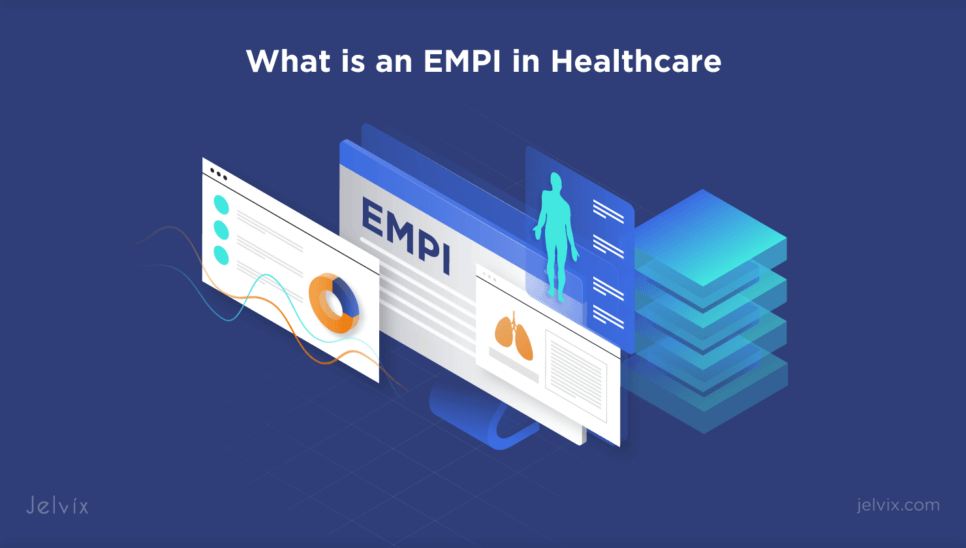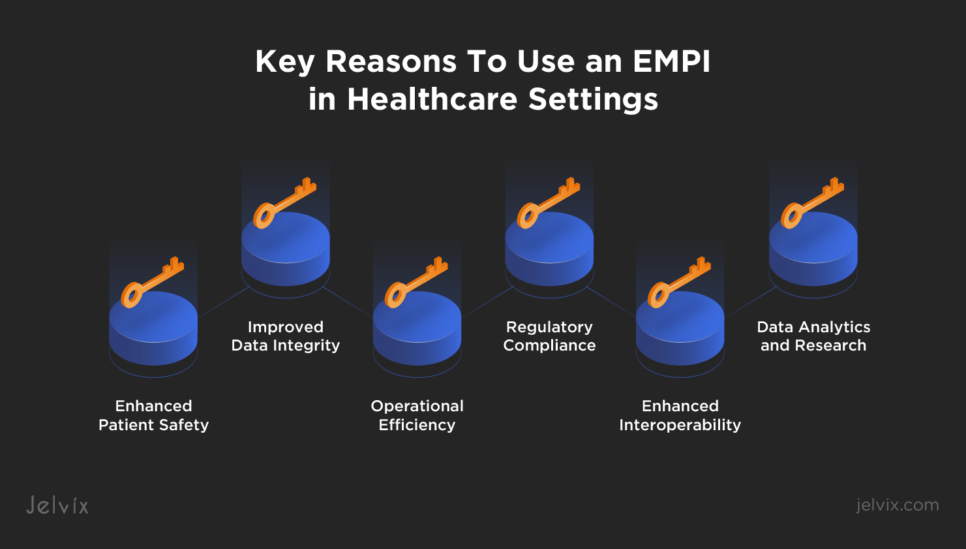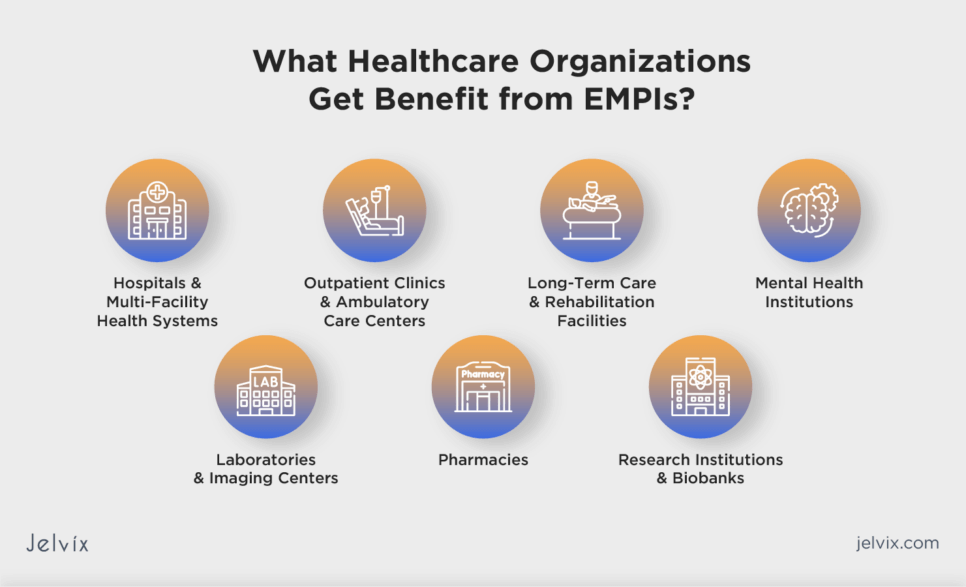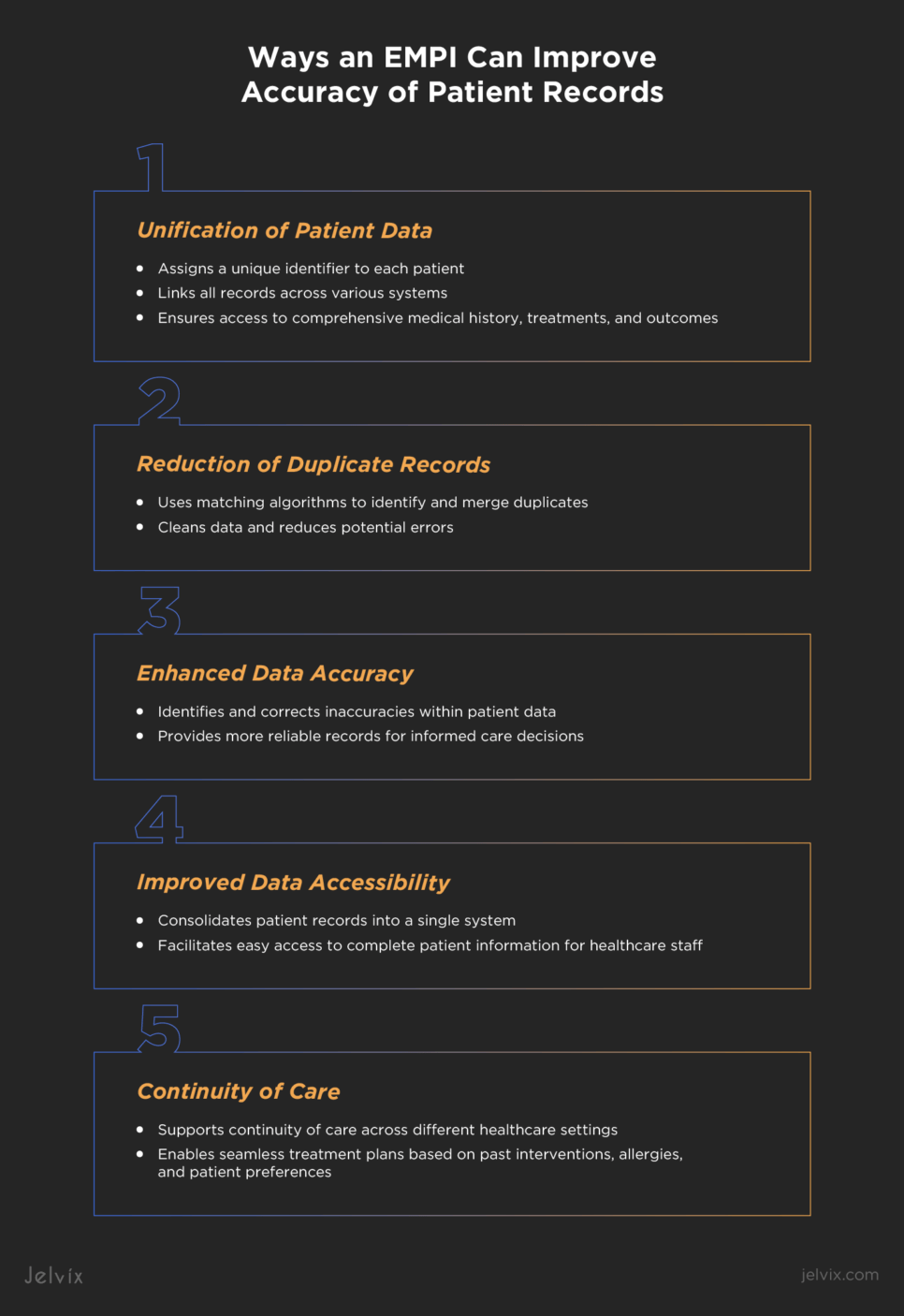The healthcare sector generates huge amounts of patient records, and it is getting harder for clinics to manage all this data. This often results in duplicate records that can provoke critical medical errors.
A report by PSQH shows that the success rate of matching a patient to their records might be only 80% within the same healthcare facility and can fall to 50% when different organizations share patient info electronically.
If you struggle to reduce duplicates in patient records and need a solution that can seamlessly integrate with your medical system, read this article. You’ll find out how an EMPI can help you make records more accurate, tips to choose the right solution, and proven steps to implement an EMPI into your healthcare settings.
What an EMPI Is and How It Works
An enterprise master patient index (EMPI) is a database that healthcare organizations use to maintain consistent and accurate patient identification across various departments and medical systems. It works by collecting patient records from multiple sources, such as electronic health records, billing systems, and laboratory information systems, to create a single, comprehensive, and up-to-date view of a patient’s health history. An EMPI assigns a unique identifier to each patient, which is used to match, merge, and link patient records across different healthcare settings.
EMPIs involve matching algorithms that compare data points like name and address to accurately identify and link records belonging to the same patient. The main types of algorithms used by EMPIs include:
- Deterministic algorithms rely on predefined rules and exact matches on attributes like name, date of birth, and Social Security Number. If all criteria match perfectly, records are considered to be of the same patient;
- Probabilistic algorithms use statistical models based on similarities in multiple attributes to determine the likelihood that two records belong to the same patient;
- Machine learning algorithms enhance EMPI’s capabilities by analyzing patterns and learning from data to improve match accuracy over time;
- Hybrid algorithms are a combination of deterministic and probabilistic approaches, that use the strengths of both methods to improve matching accuracy.
An EMPI ensures that healthcare staff has access to a patient’s complete health information, regardless of the clinic where the care was provided.
Key Reasons To Use an EMPI in Healthcare Settings
By using EMPIs, healthcare organizations can improve patient safety, data integrity, and operational efficiency. At the same time, they can fulfill regulatory requirements and support enhanced interoperability and analytics.
Enhanced Patient Safety
Medical errors are considered the 3rd leading cause of death in the U.S. By providing a unified view of a patient’s health records, EMPIs reduce the risk of errors caused by incomplete or duplicated patient information.
Improved Data Integrity
EMPIs ensure the accuracy and consistency of patient data across all systems that use these records, which is essential for effective diagnosis, treatment planning, and patient care management.
Operational Efficiency
With an EMPI, healthcare organizations can improve patient registration, reduce administrative burdens on staff, and eliminate the need for manual record filling. This can lead to increased operational efficiency and better resource allocation.
Regulatory Compliance
EMPIs help healthcare entities comply with regulations that require accurate patient identification, such as HIPAA in the U.S. By safeguarding patient information and ensuring privacy, EMPIs contribute to regulatory compliance.
Enhanced Interoperability
As healthcare moves towards integrated care models, the ability to share accurate patient data across different care settings becomes a must. EMPIs facilitate this interoperability, supporting various data formats and FHIR API solutions for coordinated care and accurate information exchange.
Data Analytics and Research
EMPIs enable healthcare organizations to use their data for analytics and research purposes. By ensuring data is accurately linked and consolidated, EMPIs enhance the quality of insights derived from data analysis, supporting population health management, clinical research, and quality improvement initiatives.
Understanding the Applications of EMPIs in Healthcare
The ability to securely and accurately link patient records across different care settings can significantly facilitate operations in a complex healthcare environment. These abilities make an EMPI an important asset for various healthcare organizations.
Types of Healthcare Organizations that Benefit from EMPIs
Since an EMPI can help enhance data accuracy, interoperability, and patient care, it can be applied across various healthcare entities, from pharmacies to hospitals.
Hospitals and Multi-Facility Health Systems
These entities benefit from EMPIs by ensuring unified patient records across multiple locations, improving care coordination and patient safety. With an EMPI, physicians can access a patient’s full medical history, treatments, and medications, reducing the risk of errors and enhancing outcomes across the whole health system.
Outpatient Clinics and Ambulatory Care Centers
EMPIs help these facilities maintain accurate patient records and share information seamlessly with hospitals, specialists, and other care providers. This enables a holistic approach to patient care, granting access to comprehensive patient records and ensuring informed treatment decisions.
Long-Term Care and Rehabilitation Facilities
For these organizations, EMPIs facilitate the integration of patient information with broader health systems, keeping care histories comprehensive and current. EMPIs support the needs of long-term care, such as tracking the progression of conditions over time and coordinating with multiple healthcare providers for timely care.
Mental Health Institutions
EMPIs enable secure and private sharing of sensitive patient information across care settings, enhancing treatment continuity for mental health patients. As a result, specialists have access to medication history and previous interventions important for effective crisis management.
Pharmacies
Pharmacies use EMPIs to improve medication management and reduce prescription errors. This integration helps pharmacists verify patient information, manage drug interactions, and communicate effectively with prescribing physicians, leading to safer medication practices.
Laboratories and Imaging Centers
They rely on EMPIs to match test results and images with the patient records, supporting accurate diagnoses. EMPIs help organize the diagnostic process by ensuring that lab and imaging data are quickly and accurately linked to patient profiles.
Research Institutions and Biobanks
EMPIs support research by accurately linking clinical data from multiple sources, aiding in patient recruitment for clinical trials and population health studies. They provide a reliable framework for managing patient consent and anonymizing data, ensuring that research is conducted ethically and in compliance with regulations.
EMPI vs Medical Record Number
As you already know, an EMPI links patient records across multiple healthcare facilities, providing a unified view of medical information under a unique identifier.
Unlike an EMPI, a medical record number (MRN) is a unique identifier assigned to a patient’s record within a single healthcare facility. While an MRN is important for internal data organization and patient identification, it does not provide a solution for integrating patient data across different healthcare settings or organizations.
Combined, EMPIs and MRNs serve distinct yet complementary roles in healthcare data management, with EMPIs addressing broader challenges of data integration and interoperability, and MRNs focusing on efficient patient data management within individual institutions.
Ways an EMPI Can Improve Accuracy of Patient Records
As reported by the HIPAA Journal, miscommunication and incorrect patient records led to almost 2,000 preventable deaths and $1.7 billion in malpractice costs. Implementing EMPIs could have prevented such outcomes by ensuring that all patient information is accurate, complete, and consolidated across multiple healthcare systems.
Unification of Patient Data
By assigning a unique identifier to each patient, an EMPI links all records related to that patient across various systems. This unification ensures that doctors have access to a comprehensive medical history, treatments, and outcomes.
Reduction of Duplicate Records
EMPIs use matching algorithms to identify and merge duplicate records. This helps to clean the data and reduce potential errors that can arise from having multiple records for the same patient.
Enhanced Data Accuracy
The process of matching and linking patient records through an EMPI helps to identify and correct inaccuracies within patient data. This results in more reliable records that physicians can trust for making informed care decisions.
Improved Data Accessibility
With patient records consolidated into a single system, healthcare staff can easily access complete patient information when needed. This accessibility is especially important for emergency care and chronic disease management as it helps ensure that decisions are based on the full scope of patient information.
Continuity of Care
By ensuring that patient records are accurate and accessible, an EMPI supports the continuity of care across different healthcare settings. Physicians can seamlessly continue treatment plans, taking into account past interventions, allergies, and patient preferences.
An EMPI vs. an MPI: Key Difference
While both an EMPI and a Master Patient Index (MPI) help manage patient identities across healthcare systems, they serve distinct roles and operate on different scales.
Unlike an EMPI, an MPI operates within a single healthcare facility, focusing on accurate data management for that specific organization, with limited cross-entity data exchange capabilities. While MPIs concentrate on preventing duplicates and ensuring data accuracy within one organization, EMPIs tackle broader challenges of integrating and organizing patient information across an entire healthcare system.
How to Choose the Right EMPI Software?
Depending on your organization’s type and needs, you may require EMPI solutions that differ in scalability, integration capabilities, cost-efficiency, and other aspects. For an accurate decision, the Jelvix team recommends that you take into account the considerations listed below.
Scalability and Flexibility
Choose an EMPI solution that can scale with your organization’s growth and adapt to changing data management needs. It should handle increasing volumes of data and integrate with new systems as your healthcare network expands.
Data Matching Accuracy
Evaluate the solution’s data-matching capabilities, including its algorithms and processes for identifying, linking, and deduplicating patient records. High accuracy in matching ensures the integrity of patient data across your systems.
Integration Capabilities
An ideal EMPI solution should seamlessly integrate with your existing healthcare information systems, such as EHRs, laboratory information systems, and billing platforms. Ensure it supports standard healthcare data formats and protocols for smooth interoperability.
Explore key steps and best practices for successful EHR implementation to enhance patient care and data security.
Compliance and Security
Ensure the EMPI solution complies with relevant healthcare data protection regulations, such as HIPAA and GDPR. It should offer robust data security features, including encryption and role-based access controls, to safeguard patient information.
User Experience
Consider the solution’s user interface and overall usability. It should be intuitive for your staff to use, with minimal training efforts required. An intuitive user experience will help in achieving high adoption rates among your team.
Vendor Reputation and Support
Research the reputation of chosen EMPI vendors. Look for providers with a proven track record of successful EMPI implementations. Comprehensive support, including training, maintenance, and customer service, is vital for smooth operation and troubleshooting.
Cost-Effectiveness
Assess the total cost of ownership, including initial implementation costs, ongoing maintenance, and potential scalability expenses. Choose a healthcare solution that offers a good balance between features and cost, providing value for your investment.
Customization
The EMPI solution should be customizable to fit your specific data management needs. Configurability allows you to tailor the system to meet your organization’s unique requirements and workflows.
Reporting and Analytics
Look for an EMPI solution that includes robust reporting and analytics capabilities. Insights generated from patient data can support decision-making, improve patient care, and optimize operational efficiency.
Discover the factors influencing the cost of healthcare app development and optimize your budget for creating innovative healthcare solutions.
Steps to Implement EMPI Solutions
Implementing an EMPI requires a strategic approach that involves several steps to ensure successful integration and functionality within a healthcare organization. Make sure to follow a step-by-step process developed by the Jelvix team for maximum efficiency.
1. Define Goals and Objectives
Begin by clearly defining what you aim to achieve with the EMPI implementation. This includes improving patient data accuracy, enhancing interoperability between systems, or facilitating patient care. Clear goals will guide the implementation process and help measure success.
2. Conduct a Needs Assessment
Assess your current data management systems, identify the sources of patient data within your organization, and understand the requirements for integrating these systems. This assessment will help tailor the EMPI solution to your specific needs.
3. Select the Right EMPI Solution
Based on the needs assessment, choose an EMPI solution that best fits your requirements. Consider factors such as scalability, data matching accuracy, integration capabilities, compliance, and cost-effectiveness.
4. Plan the Implementation
Develop a detailed implementation plan that includes timelines, milestones, roles, and responsibilities. This plan should outline the technical setup, data migration strategies, system integration steps, and training programs for staff.
5. Prepare Data for Migration
Before migrating data to the EMPI, clean and standardize the existing patient records. This process involves deduplicating records, correcting inaccuracies, and ensuring data consistency across various systems.
6. Implement the EMPI Solution
Carry out the technical setup and integration of the EMPI solution with your existing healthcare systems. This step requires close collaboration with the EMPI vendor and your IT team to ensure seamless integration.
7. Migrate Data
Migrate your prepared patient data into the EMPI, ensuring that records are accurately matched and linked. Monitor the migration process closely to address any issues that may arise.
8. Conduct Testing
Carefully test the EMPI system to ensure it functions as intended. This includes testing data matching accuracy, system performance, and interoperability with other systems.
9. Train Staff
Develop and deliver training programs for healthcare pros and administrative staff who will use the EMPI. Effective training will help ensure user adoption and maximize the benefits of the new system.
10. Monitor, Evaluate, and Optimize
Once testing is complete and staff is trained, go live with the EMPI. Continuously monitor the system’s performance, user feedback, and data accuracy, making adjustments as necessary. Regularly evaluate the EMPI against your initial goals and objectives. Use insights to optimize the system and processes for better performance and efficiency.
The Smart Way to Choose – Download Your Guide to Selecting the Right Healthcare Tech Partner!

Patient Identity Management in Healthcare
All the practices, technologies, and policies used to accurately identify and manage patient information can be unified under the patient identity management definition. This process ensures that every patient’s health records are accurately linked to a unique individual, preventing mix-ups, enhancing data integrity, and supporting seamless care delivery.
Effective patient identity management involves the use of technologies that enable consistent collection, storage, and retrieval of patient data. This includes the implementation of MPI or EMPI systems that provide a comprehensive view of health records.
Key components of patient identity management include standardized data collection protocols to ensure that patient information is captured uniformly at every point of care. Advanced identification technologies, such as biometrics or smartcards, can also be used to enhance the precision of patient identification processes.
Learn the advantages of custom healthcare CRM development for enhanced patient management and service delivery.
How Jelvix Can Improve the Quality of Patient Records
At Jelvix, we understand the outcomes of medical errors caused by duplicated patient records. As a technical partner experienced in medical software development, we assist our clients in enhancing patient care through the integration of EMPI solutions that help make records accurate and unified.
Our strategy focuses on seamless CRM-EHR Integration combined with EMPI solutions for better-quality patient data. By effectively linking identity management with EHR systems, we ensure improved and secure access to patient records.
If you are looking to develop or integrate an EMPI solution to eliminate duplicates in patient records, feel free to contact us. Our seasoned experts can provide guidance on developing software that best suits your needs.
Ready to implement an Enterprise Patient Index Solution?
Streamline patient data management and enhance care with our quality-focused solutions.














